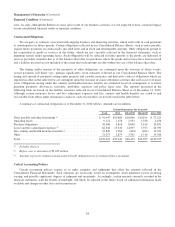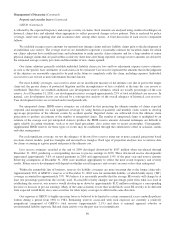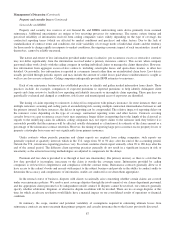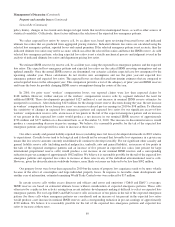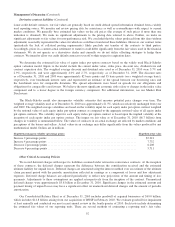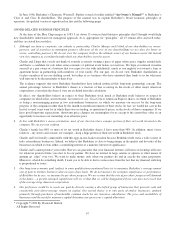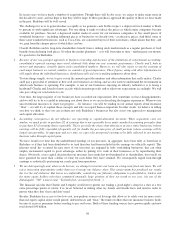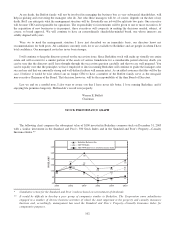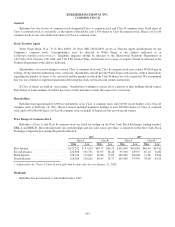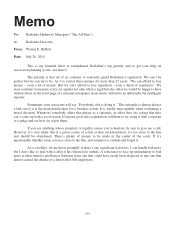Berkshire Hathaway 2010 Annual Report Download - page 96
Download and view the complete annual report
Please find page 96 of the 2010 Berkshire Hathaway annual report below. You can navigate through the pages in the report by either clicking on the pages listed below, or by using the keyword search tool below to find specific information within the annual report.
Management’s Discussion (Continued)
Interest Rate Risk (Continued)
The following table summarizes the estimated effects of hypothetical changes in interest rates on our assets and liabilities
that are subject to interest rate risk. It is assumed that the changes occur immediately and uniformly to each category of
instrument containing interest rate risk, and that no other significant factors change that determine the value of the instrument.
The hypothetical changes in interest rates do not reflect what could be deemed best or worst case scenarios. Variations in
interest rates could produce significant changes in the timing of repayments due to prepayment options available. For these
reasons, actual results might differ from those reflected in the table. Dollars are in millions.
Estimated Fair Value after
Hypothetical Change in Interest Rates
(bp=basis points)
Fair Value
100 bp
decrease
100 bp
increase
200 bp
increase
300 bp
increase
December 31, 2010
Investments in fixed maturity securities ........................ $34,883 $35,710 $34,028 $33,169 $32,405
Other investments (1) ...................................... 18,905 19,284 18,535 18,183 17,742
Loans and finance receivables ............................... 14,453 14,937 13,998 13,572 13,172
Notes payable and other borrowings:
Insurance and other .................................... 12,705 12,995 12,436 12,191 11,964
Railroad, utilities and energy ............................ 33,932 36,924 31,377 29,192 27,303
Finance and financial products ........................... 15,191 15,662 14,760 14,363 13,994
December 31, 2009
Investments in fixed maturity securities ........................ $37,131 $38,155 $36,000 $34,950 $34,013
Other investments (1) ...................................... 22,197 23,056 21,391 20,620 19,892
Loans and finance receivables ............................... 12,415 12,896 11,965 11,545 11,151
Notes payable and other borrowings:
Insurance and other .................................... 4,669 4,824 4,532 4,409 4,299
Railroad, utilities and energy ............................ 20,868 22,841 19,217 17,792 16,564
Finance and financial products ........................... 14,426 14,819 14,049 13,692 13,351
(1) Includes other investments that are subject to a significant level of interest rate risk.
Equity Price Risk
Historically, we have maintained large amounts of invested assets in exchange traded equity securities. Strategically, we
strive to invest in businesses that possess excellent economics, with able and honest management and at sensible prices and
prefer to invest a meaningful amount in each investee. Consequently, equity investments may be concentrated in relatively few
investees. At December 31, 2010, approximately 58% of the total fair value of equity investments was concentrated in four
investees.
We prefer to hold equity investments for very long periods of time so we are not troubled by short-term price volatility
with respect to our investments provided that the underlying business, economic and management characteristics of the
investees remain favorable. We strive to maintain above average levels of shareholder capital to provide a margin of safety
against short-term equity price volatility.
Market prices for equity securities are subject to fluctuation and consequently the amount realized in the subsequent sale of
an investment may significantly differ from the reported market value. Fluctuation in the market price of a security may result
from perceived changes in the underlying economic characteristics of the investee, the relative price of alternative investments
and general market conditions.
We are also subject to equity price risk with respect to our equity index put option contracts. While our ultimate potential
loss with respect to these contracts is determined from the movement of the underlying stock index between the contract
inception date and expiration date, the change in fair value resulting from current changes in the index values are also affected
by changes in other factors such as interest rates, expected dividend rates and the remaining duration of the contract. These
contracts expire between 2018 and 2026 and may not be unilaterally settled before their respective expiration dates.
94


